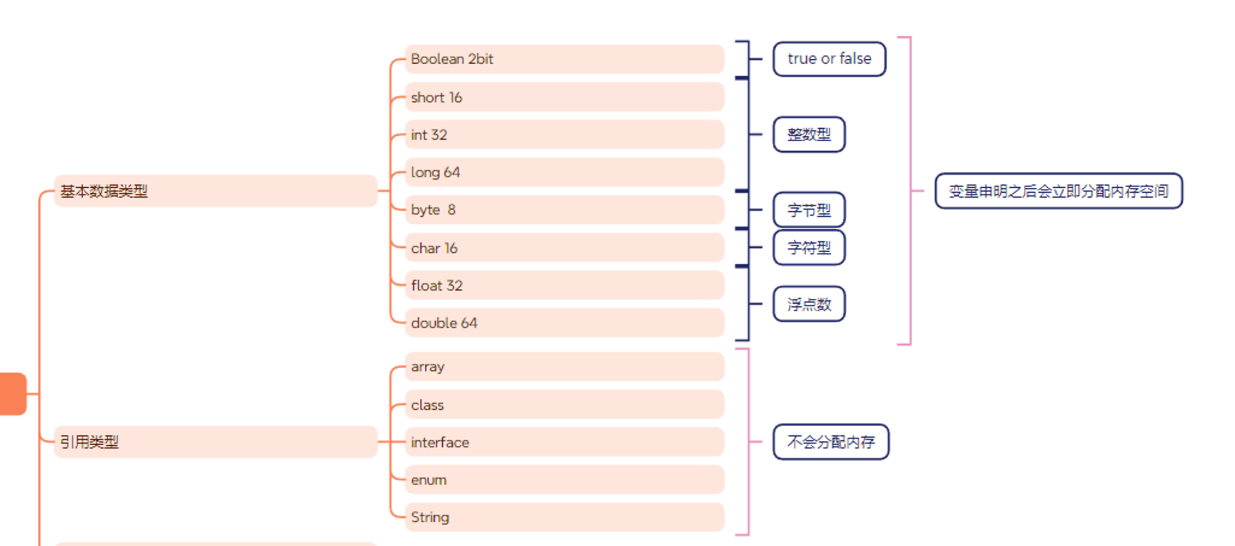数据类型

基本数据类型
| 基本类型 | 位数 | 字节 | 默认值 | 取值范围 |
|---|---|---|---|---|
| byte | 8 | 1 | 0 | -128 ~ 127 |
| short | 16 | 2 | 0 | -32768 ~ 32767 |
| int | 32 | 4 | 0 | -2147483648 ~ 2147483647 |
| long | 64 | 8 | 0L | -9223372036854775808 ~ 9223372036854775807 |
| char | 16 | 2 | 'u0000' | 0 ~ 65535 |
| float | 32 | 4 | 0f | 1.4E-45 ~ 3.4028235E38 |
| double | 64 | 8 | 0d | 4.9E-324 ~ 1.7976931348623157E308 |
| boolean | 1 | false | true、false |
浮点数
浮点数得精度运算
无限循环的小数存储在计算机中,多余的只能截断
float a = 2.0f-1.0f;
float b= 1.8f-1.7f;
System.out.println(a == b);
//output:false- 解决精度丢失
- BigDecimal
BigDecimal
BigDecimal c = new BigDecimal("1.0");
BigDecimal d = new BigDecimal("0.9");
System.out.println(c.subtract(d));java 中 Long 是最大的正数类型 64 位 超过则使用 BigInteger 内部使用 int[]数组存储任意大小的整形数据
实现对浮点数的运算不会造成精度丢失 优先推荐入参为 String 的构造方法,或者 BigDecimal.valueof(double),double 的 toString 会按照 double 的实际能表达的精度对尾数截断
BigDecimal bigDecimal = new BigDecimal(0.1F);
System.out.println("bigDecimal = "+bigDecimal);
BigDecimal bigDecimal1 = new BigDecimal("0.1");
System.out.println("bigDecimal1 = "+bigDecimal1);
BigDecimal bigDecimal2 = BigDecimal.valueOf(0.1f);
System.out.println("bigDecimal2 = "+bigDecimal2);
bigDecimal =0.100000001490116119384765625
bigDecimal1 =0.1
bigDecimal2 =0.10000000149011612 public static BigDecimal valueOf(double val) {
// Reminder: a zero double returns '0.0', so we cannot fastpath
// to use the constant ZERO. This might be important enough to
// justify a factory approach, a cache, or a few private
// constants, later.
return new BigDecimal(Double.toString(val));
}大小比较
a.compareTo(b): 返回 -1 表示a小于b,0 表示a等于b, 1 表示a大于b。
BigDecimal a = new BigDecimal("1.0"); BigDecimal b = new BigDecimal("0.9"); System.out.println(a.compareTo(b));// 1
等值比较
应该使用 compareTo 而不是 equals
public class Demo2 {
public static void main(String[] args) {
BigDecimal bigDecimal = new BigDecimal("1");
BigDecimal bigDecimal1 = new BigDecimal("1.0");
System.out.println(bigDecimal1.equals(bigDecimal));
System.out.println(bigDecimal1.compareTo(bigDecimal));
}
}
//false
// 0
@Override
public boolean equals(Object x) {
if (!(x instanceof BigDecimal))
return false;
BigDecimal xDec = (BigDecimal) x;
if (x == this)
return true;
if (scale != xDec.scale)
return false;
long s = this.intCompact;
long xs = xDec.intCompact;
if (s != INFLATED) {
if (xs == INFLATED)
xs = compactValFor(xDec.intVal);
return xs == s;
} else if (xs != INFLATED)
return xs == compactValFor(this.intVal);
return this.inflated().equals(xDec.inflated());
}自动转换
- 由小数据转换为大数据的时候会发生自动转换 (byte,short,char) < int < long < float < double
- 整型类型和浮点型进行计算后,结果会转为浮点类型
long x = 30;
float y = 14.3f;
System.out.println("x/y = "+x/y);
//x/y =1.9607843“大”与“小”,并不是指占用字节的多少,而是指表示值的范围的大小 可见 long 虽然精度大于 float 类型,但是结果为浮点数类型
- 转换前后的数据类型要兼容,由于 boolean 类型只能存放 true 或 false,这与整数或字符是不兼容的,因此不可以做类型转换。
强制转换
强制转换使用括号 () 。 引用类型也可以使用强制转换
float f = 25.5f;
int x = (int) f;
System.out.println("x = "+x);包装类
基本类型都有对应的包装类型,基本类型与其对应的包装类型之间的赋值使用自动装箱与拆箱完成。
Integer x = 2; // 装箱
int y = x; // 拆箱- new Integer(123) 每次都会新建一个对象
- Integer.valueOf(123) 会使用缓存池中的对象,多次调用会取得同一个对象的引用。
Integer a = new Integer(123); //since 9 depreacted 推荐使用 Integer.valueOf() 可以利用缓存机制
Integer b = new Integer(123);
System.out.println(a ==b); // false
Integer c = Integer.valueOf(123);
Integer d = Integer.valueOf(123);
System.out.println(c ==d); // true
final Integer a = 128;
final Integer b = 128;
System.out.println(a==b); //false编译器会在缓冲池范围内的基本类型自动装箱过程调用 valueOf() 方法,因此多个 Integer 实例使用自动装箱来创建并且值相同,那么就会引用相同的对象
public static Integer valueOf(int i) {
if (i >= IntegerCache.low && i <= IntegerCache.high)
return IntegerCache.cache[i + (-IntegerCache.low)];
return new Integer(i);
}
private static class IntegerCache {
static final int low = -128;
static final int high;
static final Integer cache[];
static {
// high value may be configured by property
int h = 127;
String integerCacheHighPropValue =
sun.misc.VM.getSavedProperty("java.lang.Integer.IntegerCache.high");
if (integerCacheHighPropValue != null) {
try {
int i = parseInt(integerCacheHighPropValue);
i = Math.max(i, 127);
// Maximum array size is Integer.MAX_VALUE
h = Math.min(i, Integer.MAX_VALUE - (-low) - 1);
} catch (NumberFormatException nfe) {
// If the property cannot be parsed into an int, ignore it.
}
}
high = h;
cache = new Integer[(high - low) + 1];
int j = low;
for (int k = 0; k < cache.length; k++)
cache[k] = new Integer(j++);
// range [-128, 127] must be interned (JLS7 5.1.7)
assert IntegerCache.high >= 127;
}
private IntegerCache() {
}
}基本类型对应的缓冲池如下:
- boolean values true and false
- all byte values
- short values between -128 and 127
- int values between -128 and 127
- char in the range \u0000 to \u007F
基本数据和包装类
- 基本类型占用的空间更小
- 基本类型不赋值有默认值,而包装类型不赋值默认为 null
- 基本类型存储在栈中,包装类型存储在堆中
- Java 中的基本类型(如**
int、float、double、boolean** 等)通常存储在栈内存中。这是因为基本类型的值直接存储在使用它们的方法的栈帧中。基本类型的值是直接按值传递的,它们的生命周期通常随着方法的调用而开始,随着方法的返回而结束 - 另一方面,包装类型(如**
Integer、Float、Double、Boolean等)是基本类型的对象表示形式,它们用于 Java 集合框架中,以及在需要对象而非基本类型的其他情况下。由于包装类型是对象,它们的实例存储在堆内存中。当创建一个包装类型的实例时(例如通过 **new Integer(5)),就会在堆内存中分配空间来存储这个对象,而对象的引用则可以存储在栈内存中(如果它是一个局部变量)。
- Java 中的基本类型(如**
- 无论是基本类型还是引用类型的成员变量,如果它们是对象的非**
static**成员,那么这些成员变量的数据都存储在堆内存中的。- static 变量是存储在方法区的
自动装箱和拆箱
基本数据类型与包装类的转换被称为装箱和拆箱。 装箱(boxing)是将值类型转换为引用类型。例如:int 转 Integer。 拆箱(unboxing)是将引用类型转换为值类型。例如:Integer 转 int
Integer c1 = 33;//装箱
int c2 = c1;//拆箱
从字节码中,我们发现装箱其实就是调用了 包装类的 valueOf()方法,拆箱其实就是调用了 xxxValue()方法。
scene
- 场景一、将基本数据类型放入集合类
Java 中的集合类只能接收对象类型
List<Integer> li = new ArrayList<>();
for(int i = 1;i< 50;i ++){
li.add(i);
}
//反编译
List<Integer> li = new ArrayList<>();
for(int i = 1;i< 50;i++){
li.add(Integer.valueOf(i));
}- 场景二、包装类型和基本类型的大小比较
对 Integer 对象与基本类型
Integer a = 1;
System.out.println(a==1?"等于":"不等于");
Boolean bool = false;
System.out.println(bool?"真":"假");
----------------------------------------------------
Integer a = 1;
System.out.println(a.intValue() ==1?"等于":"不等于");
Boolean bool = false;
System.out.println(bool.booleanValue() ?"真":"假");包装类与基本数据类型进行比较运算,是先将包装类进行拆箱成基本数据类型,然后进行比较的。
- 场景三、包装类型的运算
对 Integer 对象进行四则运算
Integer i = 10;
Integer j = 20;
System.out.println(i+j);
--------------------------------------------------------
Integer i2 = 10;
Integer j = 20;
System.out.println(i2.intValue() +j.intValue());两个包装类型之间的运算,会被自动拆箱成基本类型进行。
- 场景四、三目运算符的使用
boolean flag = true;
Integer i = 0;
int j = 1;
int k = flag ? i : j;
--------------------------------------------------------
Integer i = 0;
int k = 1 != 0 ? i.intValue() : 1;
System.out.println(k);这是三目运算符的语法规范:当第二,第三位操作数分别为基本类型和对象时,其中的对象就会拆箱为基本类型进行操作。
因为例子中,flag ? i : j;片段中,第二段的 i 是一个包装类型的对象,而第三段的 j 是一个基本类型,所以会对包装类进行自动拆箱。如果这个时候 i 的值为 null,那么就会发生 NPE。

引用类型
- class
- enum
- interface
- array
